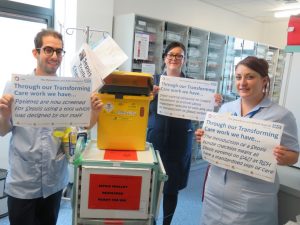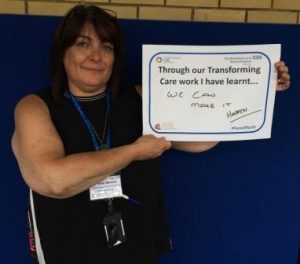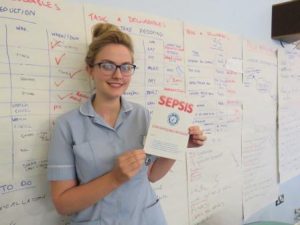Patients being treated for Sepsis have seen huge improvements in their care at Shropshire’s two acute hospitals – thanks to the introduction of techniques used by ‘the USA’s Hospital of the Decade’.
The Shrewsbury and Telford Hospital NHS Trust (SaTH) has been working to improve care for patients who suffer Sepsis and has been using techniques learnt from the Virginia Mason Institute (VMI) in Seattle, as part of a five-year partnership.

Pictured with the Sepsis trolley and holding ‘comment boards’ are staff from the Surgical Assessment Unit at the Royal Shrewsbury Hospital. From left, Staff Nurse Luigi Scarsella, Sister Kelly Brotherton and Staff Nurse Alison Hughes.
As part of today’s NHS Fab Change Day (19 October), the Trust has launched a short video that highlights the improvement work and demonstrates the importance of recognising and treating Sepsis quickly.
Since making the commitment to improve care for patients presenting with Sepsis, SaTH has held two week-long workshops that focus on making small but significant and sustainable improvements. The most recent of these proved it is possible for patients to receive all elements of the life-saving medication ‘Sepsis 6’ bundle in less than one hour, which evidence shows increases survival rates.
The results have only been achieved on a relatively small number of patients to date, all on the Surgical Assessment Unit (SAU) at the Royal Shrewsbury Hospital (RSH), but the Trust plans to continue testing the changes by measuring results on a monthly basis.
Sister Andrea Walton, process owner for the week, said: “By taking a blood trolley and converting it into a Sepsis trolley, that not only had everything needed to deliver the bundle but also came with a folder that clearly outlined with visuals exactly where everything was kept, we stopped staff from having to walk around the ward looking for equipment and various other parts.

Sister Andrea Walton
She added: “Such ideas may sound straight forward but when you are busy doing the day job you don’t always have the time needed to stand back and say ‘why don’t we do this?’ The five day workshop was really hard work but extremely rewarding.”
The Trust’s first workshop took place on the Acute Medical Unit (AM) at the Princess Royal Hospital (PRH) in Telford, and concentrated on finding innovative ways in which significant improvement could be made to the way patients presenting with Sepsis are screened.
Staff Nurse Viola Jones, Process Owner of the first Sepsis Value Steam, said: “When challenged to improve screening and recognition of Sepsis we found some people didn’t have a clear understanding of what Sepsis is. To combat this we produced a simple leaflet that explains what Sepsis is that comes with an informative quiz to ensure the information learnt in the leaflet is retained.

Staff Nurse Viola Jones
“The leaflet has helped empower staff and make them more aware of Sepsis, which as a result improves screening and recognition of Sepsis for our patients.”“The information leaflet has proved a huge success and we have even shared it with The UK Sepsis Trust and a number of other hospital Trusts.
Sepsis arises when the body’s response to an infection injures its own tissues and organs. It leads to shock, multiple organ failure and death, especially if not recognised early and treated promptly. There are around 150,000 cases of Sepsis in the UK every year and approximately 44,000 deaths.
At least four patients at SaTH die each month from Sepsis. Early recognition and screening for Sepsis is vital to ensure timely and effective treatment.
